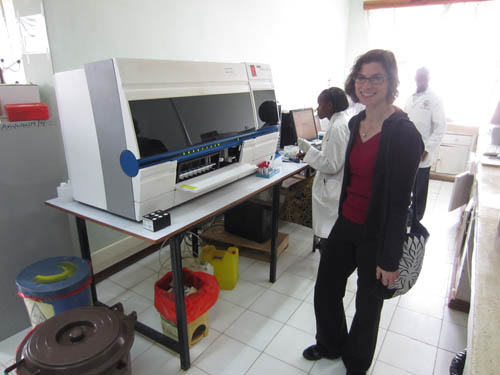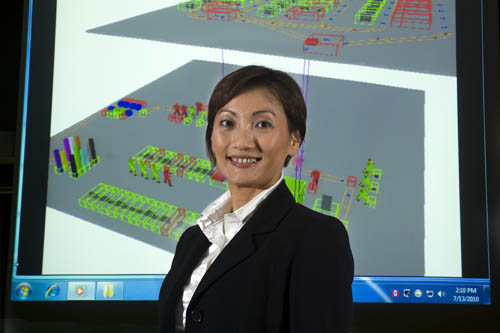Clearing roadblocks The Innovation for International Development Lab brings creative engineering to populations afflicted by poverty or war
Clearing roadblocks
| Author: | Eric Bender |
|---|---|
| Subtitle: | The Innovation for International Development Lab brings creative engineering to populations afflicted by poverty or war |
| Magazine Section: | Engagement |
| Article Type: | Feature |
| Feature CSS: | background-position: 100% 0%; |
During an infant’s first week of life, infectious diseases pose the greatest danger. Accurate diagnosis of the infection may take days — or, in low-income countries such as Kenya, may not be an option at all.
Jacqueline Linnes, assistant professor of biomedical engineering, has proposed a solution to this critical public health problem: a mobile point-of-care molecular diagnostic device that lets an untrained observer quickly spot whether the newborn suffers from one of the most common deadly pathogens.
That’s one of the challenges taken on by the new Innovation for International Development (I2D) Lab, which offers seed grants for creative engineering efforts that seek to overcome major problems for populations struggling with issues of poverty or conflicts.
Another I2D project, led by Jennifer DeBoer, assistant professor of engineering education, is developing an integrated online/classroom curriculum to bring engineering skills to street children in Kenya.
A third project, spearheaded by Yuehwern Yih, professor of industrial engineering, will create better supply chain management system and processes for delivering desperately needed supplies to Syrian refugee camps.
Housed within the Global Engineering program, I2D targets “roadblock” problems in international development whose solutions might have major impacts, says Arvind Raman, the Robert V. Adams Professor of Mechanical Engineering and associate dean for global engineering.
I2D seed grants are intended to kick-start projects that can win subsequent funding from agencies such as the U.S. Agency for International Development and foundations such as the Bill and Melinda Gates Foundation.
Just as crucially, the program also focuses on commercializing technologies generated by the projects, working with local and international business partners and with colleagues in Purdue's Burton D. Morgan Center for Entrepreneurship.
“With every I2D project, we ask if there is a startup potential, and if there is, we work closely with the local entrepreneur,” explains Joseph Pekny, interim director of the Morgan Center and professor of chemical engineering. “In the case of these African projects, Purdue can serve as an R&D unit for the companies we start up. It’s a clear win for African entrepreneurs, with African-run companies, and for our faculty, who get to work with a company that will help them target their research to the marketplace.”
Disease detection in hand
The I2D Kenya initiatives build on a longstanding Purdue partnership with Academic Model Providing Access to Healthcare (AMPATH), which provides health and related services to hundreds of thousands of people with HIV (and other health conditions) and their relatives. AMPATH is a collaboration among Moi University School of Medicine, Moi Teaching and Referral Hospital and a consortium of U.S. medical schools led by Indiana University. It is based in Eldoret, a fast-growing urban center in western Kenya.
As Jacqueline Linnes started to design her point-of-care diagnostic device for infectious disease in newborns, she reached out to AMPATH doctors to understand the Kenyan medical environment. These experts validated her list of the country’s three most common causes of sepsis (immune reaction to infection that can be lethal) in the first days of life. They also liked the idea of powering the device with a cellphone’s audio output.
“We want to help detect sepsis in infants who are born outside a hospital and don’t have access to hospital care but can be rushed in if really needed,” Linnes says. “We’re trying to get the timing down short enough to detect an infection before someone leaves a doctor’s office.” The device also should be as easy to read as a home pregnancy test.
To make a diagnosis, a small sample of blood from the infant will be dropped onto a paper filter, where bacterial cells will be gathered and broken up to release their DNA. The DNA is labeled and then amplified by a technique called LAMP (loop-mediated isothermal amplification), which can perform multiple reactions at the same temperature. Amplified DNA then travels down a lateral flow detection strip. If one of the three infections is present, it will appear in a simple, colored yes/no readout.
After visiting Eldoret in June to meet with AMPATH and local medical staff, Linnes and her students are optimizing the device’s key components. She hopes to gain follow-up funding from USAID or various foundations and to work with both local and international businesses to commercialize the resulting technologies.
“In environments where there isn’t the infrastructure or the training to do diagnostics, this really could make a big impact,” she says. “It’s also applicable for all sorts of diseases around the world, whether you’re looking at a ‘minute clinic’ in the U.S. or a community clinic in Kenya. If it works well in Kenya, then we can take it other places to see what would be needed to make it more universal.”
Engineering education in the streets
As Eldoret rapidly grows, so does the city’s population of homeless children. Jennifer DeBoer is working with the Tumaini Center, an AMPATH-backed organization with a residential location and a drop-in center for aiding street youths, on engineering coursework that can help these children increase their employability as well as grow the local economy.
“Working with the Tumaini Center director and teachers, we will create a basic engineering skills curriculum,” she says. “Students will get concept knowledge and adaptable skills, and the course will be locally relevant.” One module, for example, will cover off-grid solar energy solutions.
The curriculum will use “flipped classroom” best practices designed to get the most leverage from combined online and face-to-face learning. In flipped classrooms, “students explore content online before coming to class,” DeBoer explains. “Then in class we grapple with the tough questions, we do hands-on work, and we do problem solving with collaborative teamwork.”
Her project will develop a digital content platform that can be delivered online and offline on low-cost mobile devices, potentially smartphones if those are available, “so that students will have the capability to explore the material on their own,” she says.
DeBoer also will work with Tumaini teachers and standard Kenyan curricula to make sure that these students, who have dropped out of the Kenyan educational system, can get help with their reading, writing and mathematical skills as needed.
On the upside, “these students will have a lot of hands-on experience that most of their peers have not gotten, and they’ve had to be very resourceful,” DeBoer points out. “Creativity and resiliency are certainly a part of engineering success.”
DeBoer kicked off the project in June with a visit to Eldoret along with other AMPATH participants, and she and one of her graduate students will begin creating the platform and initial content this fall.
She expects international development agencies and foundations to be interested in funding the next stages of the project, and she will test the online educational platform and curriculum in other sites in Kenya and other low-income countries. She also believes the educational platform will create marketable products for businesses both in Kenya and outside, and will get feedback from colleagues at the Morgan Center for Entrepreneurship on the best ways to exploit these opportunities.
“I hope that what we learn here could help inform us on the ways students use a curriculum like this and how it can be part of their long-term success,” she says.
This educational initiative, Raman says, aims “to really change the way we look at street children, who are much more entrepreneurial than other kids their age — if we can do this project in Kenya, it could be adapted for many other countries.”
Supplies on the border
A decade ago in Kenya, Yuehwern Yih led the development of a supply chain management system that helped AMPATH to boost food deliveries for patients with HIV and their families. This year, Yih is tackling another daunting supply chain crisis — this one located three thousand miles almost due north, at refugee camps in Syria.
More than 10 million people have been displaced by Syria's horrific ongoing civil war, and most of this enormous group remains within the embattled country. The humanitarian agency Catholic Relief Services has run supply operations to Syrian camps, but has found it very difficult to track the supplies all the way from multiple points of acquisition on to those in the camps.
One big barrier is a lack of integration among the various supply chain systems that CRS employs. Another is the lack of Internet access and electrical power in remote and insecure areas. "You may not have power when you need it, and you may not have a device that is working the way you thought it would be," Yih says. The current delivery information, recorded on paper, may be entered into the information system weeks or months after the event, or be missing altogether.
All in all, “it’s very difficult for CRS to reconcile records from multiple locations and for their country programs to get a picture of what items they have on hand,” she says.
Under an I2D seed grant, this year Yih is building a prototype of a supply chain system that would integrate back-end supply tracking programs with mobile data collection on smartphones.
The system must balance the current needs for serving the Syrian camps with the agency’s desire to build systems that can be deployed for emergency response worldwide — and different regions have very different cultures and practices, she notes.
Yih and the graduate student assigned to the project will study the complete CRS supply chain operation in detail to better understand the tracking system and find ways to improve it. “My focus is not just in data collection but in analyzing and modeling data to make better decisions and improve the process,” she says. “That will be the next step.”
“There are a lot of sensitive issues we have to work around,” Yih notes. “We also have to be very dynamic and very adaptive in working with our collaborators. We always need backup plans, not just a B or C plan, but F and G plans. Working on this type of project really takes a lot of time and a lot of patience, but I have confidence that we can solve some of these problems.”
Beyond technology development
Overall, I2D follows a long tradition of international development at Purdue, and it reflects an increasing trend of combining creative engineering with entrepreneurship to clear major roadblocks for populations in need, Raman says.
For Purdue students, I2D research “can be the experience of a lifetime,” he adds. “They are working not only to develop technologies but to help save lives, set up local businesses and improve economic prosperity for large numbers of people.”



